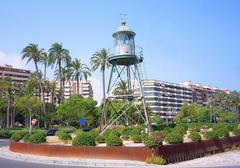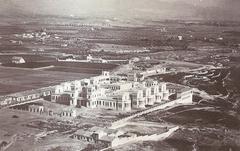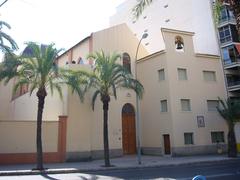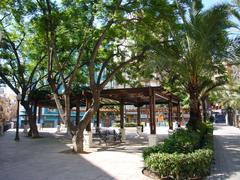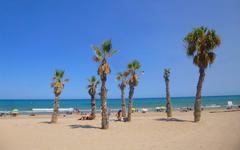
La Isleta Alicante: Visiting Hours, Tickets, and Tourist Guide
Date: 04/07/2025
Introduction to La Isleta Alicante: Historical Site and Visitor Information
La Isleta in Alicante, Spain, is a multifaceted destination where history, culture, and natural beauty converge. It consists of two notable areas: the archaeological peninsula of La Illeta dels Banyets in El Campello, recognized for its ancient settlements and the 16th-century Torre de la Illeta, and the urban glorieta known as La Isleta in Alicante’s Albufereta neighborhood, famed for its striking public art and mid-20th-century architecture.
La Illeta dels Banyets is an open-air site tracing human habitation back to the Chalcolithic period, with Iberian, Roman, and Bronze Age layers, as well as the Torre de la Illeta—a symbol of coastal defense from the 16th century. Entry is free, and visitors can enjoy guided tours and cultural events that bring the peninsula’s past to life (audiala.com).
Meanwhile, the La Isleta glorieta in Alicante serves as a vibrant urban hub, marked by Eusebio Sempere’s kinetic sculpture “La Pirámide.” This space embodies Alicante’s passion for public art and community gathering, blending artistic heritage with everyday city life (es.wikipedia.org).
La Isleta is not only a historical site but also a gateway to Alicante’s broader attractions, like Santa Bárbara Castle, the Old Town, and sun-drenched beaches. Its layered history and dynamic setting make it an essential stop for anyone exploring Spain’s Costa Blanca (veganderlust.com, to-spain.com).
This comprehensive guide provides all the details you need for a rewarding visit, including history, opening hours, ticket information, transportation, accessibility, nearby attractions, and practical tips. Whether you’re a history enthusiast, art lover, or nature explorer, La Isleta offers a unique window into Alicante’s past and present (audiala.com, es.wikipedia.org).
Table of Contents
- Origins and Strategic Importance
- Archaeological Layers: From Prehistory to Rome
- The 16th-Century Defensive Network: Torre de la Illeta
- Role in Regional Defense and Communication
- Visiting La Isleta and Torre de la Illeta: Practical Information
- Guided Tours and Special Events
- Visual Highlights
- Frequently Asked Questions (FAQ)
- Cultural and Educational Significance
- La Isleta in Alicante’s Historical Context
- Visitor Experience: Engaging with History
- La Isleta Alicante: Urban Context and Architectural Heritage
- Artistic and Cultural Identity
- Social and Community Role
- Integration with Alicante’s Urban Fabric
- Visitor Information: Hours, Tickets, and Access
- Visitor Experience and Practical Insights
- Visiting La Isleta, Alicante: Hours, Tickets, and Top Historical Sites
- La Isleta Alicante Visitor Guide: Hours, Tickets & Top Tips
- Summary and Key Tips
- References and Further Reading
Origins and Strategic Importance
La Illeta dels Banyets, located in El Campello north of Alicante city, boasts a strategic position along the Mediterranean coast. This small peninsula has drawn human activity since the Chalcolithic (Copper Age), as evidenced by archaeological finds spanning multiple eras (audiala.com). Its natural harbor and vantage point made it ideal for both settlement and maritime defense, influencing its continuous occupation and role in coastal security.
Archaeological Layers: From Prehistory to Rome
Archaeological excavations have uncovered a wealth of history at La Illeta dels Banyets:
- Chalcolithic and Bronze Age: Early dwellings and burial sites (circa 2500–1800 BCE) indicate established communities practicing agriculture and fishing.
- Iberian Period: Settlement flourished from the 6th to 1st centuries BCE, with artifacts such as ceramics and ritual objects revealing active trade and metallurgy.
- Roman Era: The peninsula saw further development, with a villa and fish-salting factory (for garum), as well as baths and industrial facilities. The “Banyets de la Reina” (Queen’s Baths) refer to ancient rock-cut pools likely used for fish processing (mapcarta.com).
The 16th-Century Defensive Network: Torre de la Illeta
The Torre de la Illeta, built between 1554 and 1557, was part of a network of coastal watchtowers commissioned by the Spanish Crown to counter Berber pirate raids (audiala.com). The tower’s robust walls and elevated position allowed for surveillance and communication with other towers using smoke and fire signals (Minube). It stands as a testament to the region’s defensive strategies and technological ingenuity of the 16th century.
Role in Regional Defense and Communication
Torre de la Illeta’s role extended from observation to active defense, with a small garrison responsible for signaling and, when necessary, repelling invaders. The network of towers protected the coastline, trade, and local communities, reinforcing royal authority and safeguarding economic activity (audiala.com).
Visiting La Isleta and Torre de la Illeta: Practical Information
Visiting Hours
- Summer (April–October): 9:00 AM – 7:00 PM
- Winter (November–March): 10:00 AM – 5:00 PM
- Always verify opening hours on the official El Campello tourism website before visiting.
Tickets and Admission
- Entry: Free, with donations welcome for site preservation.
Accessibility
- Main paths are suitable for most visitors, but terrain can be uneven in places. Comfortable footwear is recommended.
How to Get There
- By Car: Parking available nearby.
- By Public Transport: Buses from Alicante and El Campello stop close to the entrance.
- On Foot/Bike: Scenic coastal trails connect the site with El Campello.
Nearby Attractions
- Combine your visit with El Campello’s Roman archaeological park, the lighthouse, or enjoy sunset photography and coastal walks.
Guided Tours and Special Events
Seasonal guided tours provide historical context and archaeological insights. Book ahead during peak seasons. Special cultural events and reenactments are occasionally held—check local calendars for details.
Visual Highlights
- Torre de la Illeta: Panoramic Mediterranean views.
- Banyets de la Reina: Ancient rock-cut pools.
- Peninsula Landscapes: Coastal vistas and natural scenery.
Frequently Asked Questions (FAQ)
Q: Is there an entry fee?
A: No, entry is free.
Q: Are pets allowed?
A: Yes, on a leash.
Q: Can the tower be climbed?
A: Interior access is limited, but the surrounding area is accessible.
Q: When is the best time to visit?
A: Year-round, with longer hours in summer.
Q: Are guided tours available?
A: Yes, seasonally—book in advance.
Cultural and Educational Significance
La Isleta is an emblem of El Campello and Alicante’s wider heritage. Its archaeological remains and interpretive signage offer educational value, illustrating Mediterranean civilizations and their maritime connections (Costa Blanca).
La Isleta in Alicante’s Historical Context
La Isleta’s evolution mirrors Alicante’s history of settlement, commerce, and defense. From ancient times through the Roman era to the age of piracy, it reflects the city’s resilience and adaptability (mycostablanca.net). Today, it remains a vital part of the community and a bridge to the past.
Visitor Experience: Engaging with History
Visitors can walk in the footsteps of ancient settlers and soldiers, explore ruins, and enjoy panoramic Mediterranean views. Informational panels and tours make the site accessible to all ages (audiala.com).
Visual Gallery
The Torre de la Illeta illuminated against the Mediterranean sky.
Ancient rock-cut pools known as Banyets de la Reina.
Breathtaking coastal views from the peninsula’s elevated vantage points.
La Isleta Alicante: Urban Context and Architectural Heritage
Urban and Architectural Heritage
The glorieta of La Isleta in Albufereta, Alicante, has been a city landmark since the late 1960s. It once hosted a modernist café, a social hub later replaced by a fountain and Eusebio Sempere’s “La Pirámide” kinetic sculpture after the café’s demolition in 2007 (es.wikipedia.org).
Artistic and Cultural Identity
Sempere’s work symbolizes Alicante’s dedication to public art and cultural innovation, echoing the city’s broader agenda of integrating creative expression into daily life (es.wikipedia.org). Museums and festivals, such as the Hogueras de San Juan, further enrich the city’s cultural landscape (explorecity.life).
Social and Community Role
La Isleta glorieta fosters community interaction and social cohesion, serving as a gathering spot and pedestrian-friendly space in the Albufereta district. Its location by the beach and residential areas enhances its role as a bridge between nature and urban life (visitcostablancaspain.com).
Integration with Urban Fabric
Alicante’s cityscape blends historic districts with modern amenities. La Isleta’s transformation from a café to a public art installation reflects the city’s evolving urban vision and commitment to accessible, vibrant public spaces (espanaguide.com).
Visitor Information
- Access: Open 24/7; no tickets required.
- Transport: Easily reached via tram (Albufereta stop) or on foot.
- Accessibility: Generally accessible, though some beach areas have inclines.
Visiting La Isleta, Alicante: Hours, Tickets, and Top Historical Sites
Santa Bárbara Castle
An iconic fortress atop Mount Benacantil, with free entry and sweeping city views. Open daily, with hours varying by season (Veganderlust).
Old Town (El Barrio de Santa Cruz)
A labyrinth of colorful streets and traditional homes, best explored during the day.
Alicante City Hall and Plaza
Baroque architecture and a lively plaza for festivals and events.
Natural Attractions
- Postiguet Beach: Golden sands and urban amenities.
- Explanada de España: Mosaic-tiled promenade lined with palms.
- Alicante Marina: Dining, boat tours, and entertainment.
Museums and Gastronomy
- MACA Museum: Free entry, 20th-century art.
- Mercado Central: Fresh produce and local delicacies.
- Restaurants: Tapas, seafood, and regional specialties.
Day Trips
- Tabarca Island: Marine reserve accessible by ferry.
- Nearby Villages: Altea, Villajoyosa, and Calpe for unique coastal experiences.
La Isleta Alicante Visitor Guide: Hours, Tickets & Top Tips
Getting There
Accessible by bus, tram, taxi, or on foot. Parking is limited in peak seasons (Alicante Turismo).
Visiting Hours and Tickets
Open access year-round, no ticket required. Best visited during daylight.
Best Time to Visit
Spring and autumn offer pleasant weather and fewer crowds (To Spain).
What to Pack
- Comfortable shoes
- Sun protection
- Water and snacks
- Swimwear if planning to swim
- Light jacket for evenings
Safety and Accessibility
Safe and family-friendly, though some trails are uneven. Swimming is allowed but unsupervised.
Responsible Tourism
Carry out trash, respect wildlife, and avoid open flames.
Summary and Key Tips
La Isleta in Alicante unites ancient history with modern culture and natural beauty. Free access, well-connected transport, and varied attractions make it suitable for all visitors. For the most enjoyable experience, visit in spring or autumn, pack appropriately, and follow responsible tourism practices. Use the Audiala app and official resources for up-to-date information and guided experiences (alicanteturismo.com, to-spain.com).
References and Further Reading
- Visiting La Isleta: History, Tickets, and Tips for El Campello’s Historic Peninsula, 2024, Audiala
- La Isleta Alicante: Visiting Hours, Tickets, and Cultural Significance, 2024, Wikipedia
- Visiting La Isleta, Alicante: Hours, Tickets, and Top Historical Sites, 2024, Veganderlust
- La Isleta Alicante Visitor Guide: Hours, Tickets & Top Tips for Exploring This Coastal Gem, 2024, To Spain
- Mediterranean Coastal Defense Towers: History and Architecture, 2024, Minube
- La Isleta in Alicante’s Broader Context of History, 2024, My Costa Blanca
- Alicante Urban and Cultural Guide, 2024, Explore City Life
- Alicante Tourist Map and Guide, 2024, Tourist Places Guide
- Alicante Events and Festivals, 2024, Alicante Turismo


